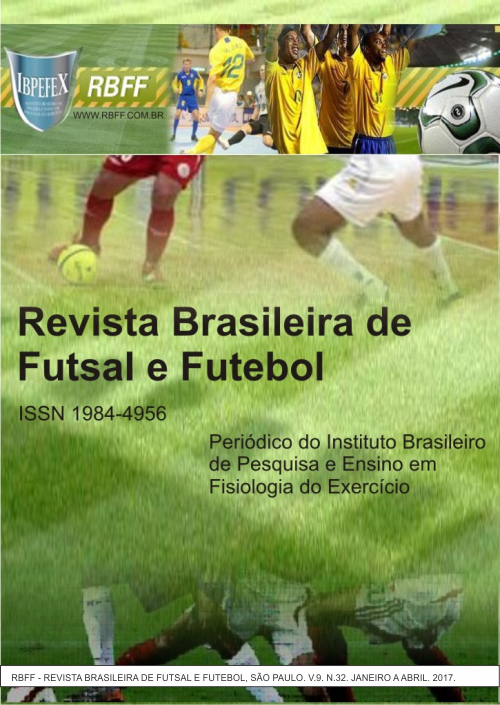Physical and behavioral analysis of young athletes practicing field football, during different training designe
Abstract
The physiological demands which individuals are subjected during a football match have been well documented in academic and reported in the literature of different parameters such as total distance traveled, average speed and heart rate. However, there is limited focus on training and its possible effects on the child's body sessions investigations. The aim of this study was to analyze physiological and behavioral aspects of young athletes in football, through different training sessions. Methodology: The study evaluated 08 male subjects who underwent three sessions of different designes training (A - technical, B - tactical and C - game) in the practice of football. The proposition was to investigate the distance covered in the sessions, caloric expenditure and variables such as heart rate, actual and estimated maximum, medium and minimum. The designes C was that children had the greatest distance to the caloric expenditure designes B presented 40% higher than designating A. Finally, the maximum heart rate did not differ between groups, but the average was more intense in designes C.
References
-Bangsbo, J. Energy demands in competitive soccer. Journal of Sports Sciences, London. Vol. 12. p. 5-12. 1994.
-Bangsbo, J. The physiology of soccer, with special reference to intense intermittent exercise.1991.
-Bangsbo, J.; e colaboradores. Fitness Training in Football -AScientific Approach. University of Copenhagen: August Krogh Institute. Denmark. Bangsbo, J.(1994): The Physiology of Soccer-With Special Reference to Intense Intermittent. Vol. 13. Núm. 1. p. 35. 2005.
-Bianco, M. A. Importância da Capacidade Cognitiva no Comportamento Tático dos Esportes Coletivos: uma abordagem no Basquetebol. In: I Prêmio INDESP de Literatura Desportiva. Instituto Nacional de Desenvolvimento do Desporto. Vol. 2. p. 95-147. 1999.
-Bruce, R. A.; Kusumi, F.; Hosmer,D. Maximal oxygen intake and nomographic assessment of functional aerobic impairment in cardiovascular disease. American Heart Journal. Vol. 85. Núm. 4. p. 546-562. 1973.
-Di Salvo, V.; e colaboradores. Performance characteristics according to playing position in elite soccer, J Sports Med. Vol. 28. Núm. 3. p. 222-227. 2007.
-Godinho, L. S.; Figueiredo, A. J. B.; Vaz, L.M.T. Caracterização métrica em futebolistas sub 15. 2013.
-Gorostiaga, E. M.; e colaboradores. Diferences in physical Wetness among indoor and outdoor elite male soccer players. European Journal of Applied Physiology. Vol. 106. Núm. 4. p. 483-491. 2009.
-Helgerud, J.; Engen, L. C.; Wisloff, U.; Hoff, J. Aerobic endurance training improves soccer performance. Medicine and Science in Sports Exercise. 2001.
-Helgerud, J.; e colaboradores. Aerobic endurance training improves soccer performance. Medicine and Science in Sports and Exercise. Vol. 33. Núm. 11. p. 1925-1931. 2001.
-LIDESAN. Liga Santista de futebol 2014. 2014. Disponível em:
-Mendez-Villanueva, A.; e colaboradores. Match play intensity distribution in youth soccer. Int J Sports Med. Vol. 34. Núm. 2. p. 101-110. 2013.
-Quintão,R.C.; e colaboradores. Quantificação e comparação da carga externa de diferentes conteúdos de treinamento específicos do futebol em relação ao jogo utilizando um GPS com acelerômetro, 2014.
-Ramirez-Campillo, R.; e colaboradores. The Effects of Interset Rest on Adaptation to 7 Weeks of Explosive Training in Young Soccer Players. Journal of Sports Science & Medicine. Vol. 13. Núm. 2. p. 287. 2014.
-Stolen, T.; e colaboradores. Physiology of soccer an update. Sports Medicine, Auckland. Vol. 35. Núm. 6. p. 501-536. 2005.
Authors who publish in this journal agree to the following terms:
- Authors retain the copyright and grant the journal the right of first publication, with work simultaneously licensed under the Creative Commons Attribution License BY-NC which allows the sharing of the work with acknowledgment of the authorship of the work and initial publication in this journal.
- Authors are authorized to enter into additional contracts separately for non-exclusive distribution of the version of the work published in this journal (eg, publishing in institutional repository or book chapter), with acknowledgment of authorship and initial publication in this journal.
- Authors are allowed and encouraged to post and distribute their work online (eg, in institutional repositories or on their personal page) at any point before or during the editorial process, as this can bring about productive change as well as increase impact and impact. citation of published work (See The Effect of Free Access).





